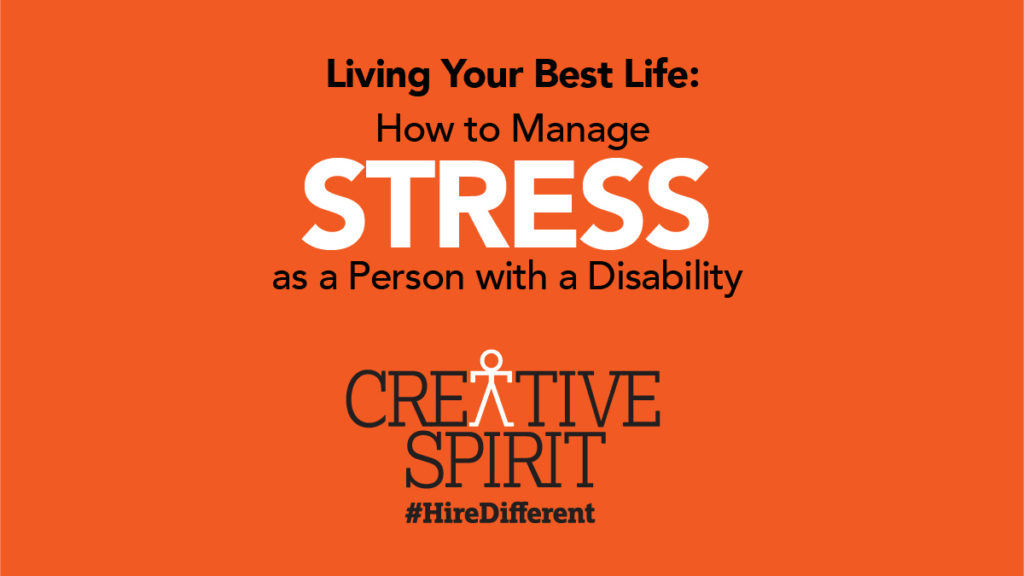By Menachem Rephun, Communications Manager Creative Spirit and Self Advocate

It’s no secret that living with a disability isn’t always easy. From managing physical and emotional exhaustion, to loneliness, challenges with self-esteem, and anxiety about disclosure, having a disability can entail significant levels of stress. According to the Centers for Disease Control (CDC), a 2018 study found that adults with disabilities reported experiencing mental distress almost five times as often as those without disabilities. On her blog “Blind Girl Adventures,” disability self-advocate Sassy Wyatt observes that “the mind and body are strongly linked, and if you feel stressed on the inside it could exacerbate your condition and the way you feel on the outside.” For April’s Stress Awareness Month, we’re sharing the insights of self-advocates and health experts on practical, effective strategies for managing and overcoming stress.
1. Volunteering
Loneliness and isolation are major causes of stress, and studies have shown that people with disabilities are more heavily impacted than any other group. According to CHRT.org, 40% of adults with a disability or chronic condition have reported experiencing loneliness and social isolation. Stress is not only unpleasant, but dangerous, potentially leading to health problems like headaches, asthma, and diabetes. This year’s Stress Awareness Month is about “Community”, and the important role of social connection in everyday life. As Stress.org explains, “Relationships are one of the most important aspects of our lives. People who are more socially connected to family, friends, or their community are happier, physically healthier and live longer, with fewer mental health problems than people who are less well connected.” Stress.org points out that people in neighborhoods with a stronger sense of community experience lower rates of mental health problems than those in neighborhoods without that community bond, regardless of the neighborhood’s economic level. Volunteering can be a great outlet for developing that sense of connection and reducing stress by shifting one’s focus outward, rather than inward. “Being able to talk through problems and share our worries with others decreases our stress levels,” Stress.org explains. “As the saying goes, a worry shared is a worry halved, and less worry equals less stress.” The site also recommends the “30-Day Challenge,” which involves choosing one activity to carry out on a daily basis for your physical, mental, and emotional well-being throughout April. “We are not meant to exist in isolation or feel alone,” Stress.org observes. “Instead, we need to share our talents with others in a way that will bring value to our communities.”
A 2021 New York Times report likewise found that according to experts, “volunteering not only helps people feel less lonely, it can also improve physical well-being. A five-year study of more than 800 people in Detroit found that helping others who don’t live with you can act as a buffer against the negative effects of stress.” For people with disabilities experiencing loneliness, volunteering can be enormously beneficial in developing a sense of connection and purpose in helping others, including those who might be encountering similar issues. For those interested, Volunteerism.org offers a wide range of volunteer resources and opportunities for those interested. Their website can be found here: https://www.idealist.org/en/volunteer-resources?pq.
2. Taking Care of Emotional Health
Being conscientious about one’s emotional and mental well-being is extremely important when it comes to reducing stress. As Family Doctor.org explains, “Emotional health allows you to work productively and cope with the stresses of everyday life. It can help you realize your full potential. It helps you work with other people and contribute to society.” To maintain and improve emotional health, a Family Doctor recommends being aware of one’s emotions and reactions (i.e. noticing what makes you sad, angry, or frustrated, and trying to change that); expressing one’s feelings, and letting people know when something is wrong; making time for things you enjoy and focusing on the positive aspects of your life; and surrounding yourself with healthy, positive people.
Meena Dhanjal, an author and memoirist living with paralysis, also offers guidance on improving emotional health. “Whether you live with a disability or if you’re able-bodied, we all deal with stress,” she writes in an article for Medical180.com. “Some of us have stress related to our jobs or our home life. Others may just feel extra pressure on their lives from financial situations like debt. Life seems to bring stressful situations to our door, whether we’re prepared or not. That’s why it’s important to find ways to cope.” Some of Dhanjal’s recommended strategies include deep breathing exercises; organizing at home and/or work; creating a list of things you’re grateful for; and Kundalini yoga, which she writes has allowed her to “live in the moment” and overcome anxiety about problems beyond her control. In an article on mental health for people with disabilities, Abilities.com recommends “scheduling time to meditate or deep breathe and reading a favorite book genre. Spirituality is another way people stay centered emotionally. Learning to manage a schedule helps manage stress, especially by not procrastinating on projects or tasks.”
3. Guided Imagery
A more unique, fascinating, and outside-the-box approach to stress relief in the form of meditation/therapy is known as “guided imagery”. Put simply, “guided imagery” (also called guided meditation, visualization, or mental rehearsal) utilizes the power of imagination to relieve anxiety and stress. According to Headspace.com, “The benefits of guided imagery are vast — there is research that shows the practice can reduce fear and anxiety, lessen the frequency of headaches, and has been proven to decrease psychological distress in cancer patients.” Additionally, GuidedImageryDownloads.com notes that “46 studies conducted between 1968 and 1998 found that guided imagery can help to reduce stress, anxiety, depression, pain, and many chemotherapy side effects while also reducing blood pressure.” In his autobiography As Long As I Live, Israeli author Aharon Margalit explains guided imagery as follows: “Researchers claim that the brain makes no distinction between real experiences and equivalent, imagined experiences. Both create the same flurry of activity, connections, and pathways within the brain. Therefore, any positive experience – even an imagined one – strengthens our positive attributes, such as self-confidence, courage, and belief in ourselves.” Margalit describes how guided imagery helped him overcome a severe stutter that developed after a lengthy bout with polio as a child. One of the most appealing aspects of guided imagery is its simplicity and accessibility, as it can be effectively practiced from the comfort of your own home, with nothing more than your own imagination (although having a professional therapist or guided imagery recording can also help). Those interested in learning more about guided imagery can visit https://www.verywellmind.com/use-guided-imagery-for-relaxation-3144606, which offers clear guidance on the benefits of guided therapy and how it can be practiced.
4. How Employers Can Help With Stress Management
Thus far, we’ve covered strategies for managing stress on an individual level, but employers can implement stress management to benefit employees with disabilities as well. In a 2003 study, researchers from Barry University’s Department of Psychology reported that stress management interventions “have been found to improve physical and mental health, reduce costs to employers, and facilitate the reintegration of injured individuals into the work environment.” Understood.org writes that developing a culture of inclusion for employees with disabilities is an effective approach for managing stress, as it empowers front-line managers to deal with stress when it comes up. “Inclusive companies acknowledge that employees have lives outside the workplace,” the site explains. “And a culture of disability inclusion can help managers learn communication skills to better support their teams. That way, when stress inevitably pops up at work, they’ll know how to address it in the simplest and most effective way.” Welcoa.org points out the wide range of benefits that come with decreased stress in the workplace, including strong company culture, fewer sick days, employee retention, and talent acquisition, and the fact that actively working to reduce stress shows that an employer cares about their employees. Simply by developing a more inclusive and equitable workplace, businesses can dramatically improve the emotional and physical health of employees with disabilities.
The bottom line is that living in today’s fast-paced world can be a stressful experience for anyone, all the more so for those living with disabilities. As a result, whether at work, at home, or at school, stress management is absolutely essential for physical and mental health. If you live with a disability, we hope that the strategies outlined in this article will help you manage stress more effectively and build confidence and self-advocacy. Feel free to share this article with friends, co-workers, and family, and visit us at https://www.creativespirit-us.org/ to learn more about how Creative Spirit is working to make employment truly equitable for people with disabilities.






